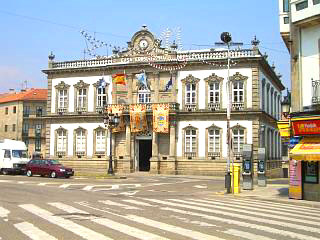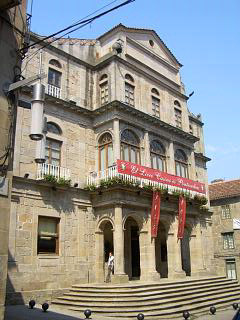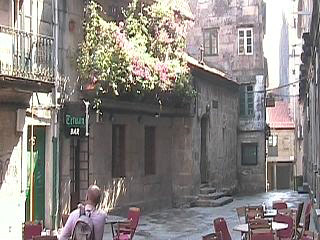Pontevedra old town – a first view
As you leave Pontevedra's alameda you cross a busy junction with the city's old town directly in front of you and the ruin of "San Domingos" church to your right. Straight ahead however is the "Pazo do Concello", town hall and council offices, which has a granite and white rendered frontal facade.
Pazo do Concello
The "Pazo do Concello" (below right) has a large double level, four columned entrance with
 symmetrically balanced wings either side and needs no introduction as Pontevedra's town hall. It is far smaller than some of the other buildings lining the main square, but aesthetically more pleasing and some how less dour than the gargantuan structures you pass by in order to reach it.
symmetrically balanced wings either side and needs no introduction as Pontevedra's town hall. It is far smaller than some of the other buildings lining the main square, but aesthetically more pleasing and some how less dour than the gargantuan structures you pass by in order to reach it.
Beyond the "Pazo do Concello" the older district of Pontevedra dips down and you can wind your way along one of a couple of alternate routes. Just past the town hall, the recently restored long and narrow city theatre, "Teatro Principal" sits to the right. This theatre is built on the original site of St. Bartolomeu's church which was destroyed in 1842. Unfortunately, I believe the theatre is now a casino.

To the left, the grand front entrance of the theatre building.
On the lower side of the theatre is a narrow lane called the "rua Tetuan" and on this alley there is the "Nazarene chapel" also called the chapel of the "immured women". This chapel originates from the middle ages and the reason behind its name lies in the fact that its inhabitant nuns only left the chapel once – after they died. This building is small and demure and you can easily miss it. It does however have a coat of arms on its narrow facade.
In addition to the theatre and ancient chapel, this area of Pontevedra's old quarter has several other buildings dating back many years including a fifteenth century house just across from the "Teatro Principal". It is also from this point that you can easily reach the first of Pontevedra's famous squares, the Prazo do Teucro, which you can find out about by clicking on this link, or selecting the Teucro button in the menu bar to the right.
below, the small chapel of the "immured women" is the single level structure beyond the building with the plant life spreading across its roof. It has one door and no windows.

Continuing a downward path and heading roughly towards the center of the old district, you reach a junction where five different lanes meet. Quite aptly this spot is known as the "Praza de Cinco Ruas" (square of five roads) and has at its center a highly detailed "cruceiro" (stone cross) which dates back to 1773. Galicia is littered with these crosses and they can be found in plazas, at cross roads and in places of commemoration, but this one is a particularly fine example. The junction of the five roads is also the site of a house formerly owned by a famous Galician writer called quot;Valle Inclan quot;.
Just a minute or two from the "Praza de Cinco Ruas" (photo right) are a couple more sight seeing stops, although neither impressed us.

The first is the "Casa do Baron de Casa Goda" which is now a parador (state run hotel). This building was once a large house (possibly two) and is quite attractive, but not worth going out of your way to see. Its dual merits lie in its neoclassical facade, which may date back as far as the sixteenth century, and the fact that it was once owned by the Count of "Maceda".
The second stop in this vicinity is the "Chapel of the Appearances", where sister "Lucia" lived. Unfortunately we were unable to determine her significance and unless you know and appreciate the religious importance of this chapel it is certainly not worth a visit.
Return to Pontevedra home.

